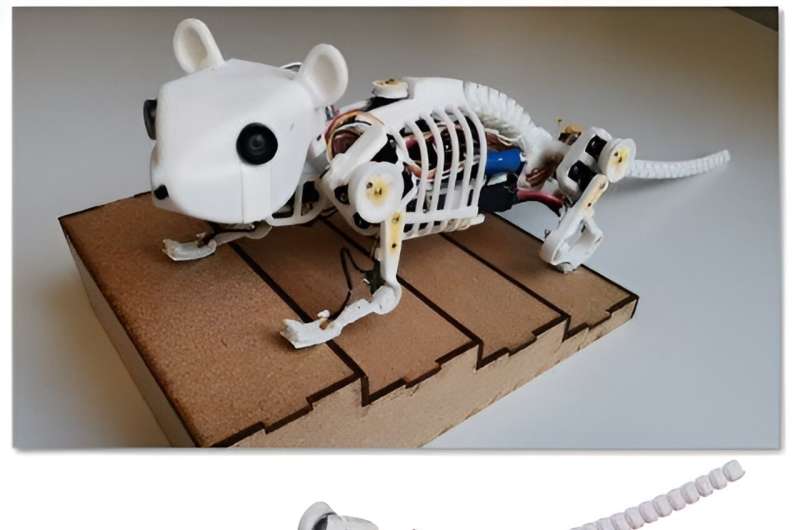Adding a flexible spine and tail makes mouse robot more nimble

A team of roboticists at Technical University of Munich, in Germany, working with a colleague from Sun Yat-sen University, in China, has improved the nimbleness of a quadruped robot by adding a flexible spine and tail. The group has reported on their project in the journal Science Robotics.
Most four-legged robots that are currently used in business or military applications have legs fixed to a strong, stiff back. Such robots must rely on computational processing and communications between limbs to remain upright and to walk and run. But, as the research team notes, virtually every four-legged animal has a flexible spine—and most have a tail.
Spines, despite being made of bone, are typically flexible due to their segmented design. Roboticists have known for years that building quadrupeds with such flexible spines would improve nimbleness but the added complexity did not seem worth the effort. For this new study, the researchers found that a flexible spine allowed them to reduce the complexity of the legs, creating a more refined robot that bends slightly back and forth as it walks.
The robot the team built very much resembles a mouse—the plastic head they affixed to its front was modeled as such—but it appears more like an animated skeleton. There are segmented plastic bones that look much like of those of a real mouse spine, along with plastic ribs and a plastic segmented tail. The legs and paws are quite different from the real thing, however; they are much more like the springy prosthetic legs and feet worn by human amputees.
Through the ribs, the electronic innards are visible. They serve to power the robot, which involves moving the legs back and forth and controlling the pulleys that serve as tendons. The research team notes that the tendon–pully system precluded the need for any type of musculature system.
After building their mouse robot, the team tested it by running it through four exercises: walking, balancing, turning and maze navigation. They ran each exercise twice, one with the spinal system turned on and once with it turned off.
In all the exercises, the robot mouse performed much better with the system turned on. It was in navigating the maze, however, that the system truly showed its superiority—the robot was able to complete the course an average of 30% faster with the system turned on versus off.
More information:
Zhenshan Bing et al, Lateral flexion of a compliant spine improves motor performance in a bioinspired mouse robot, Science Robotics (2023). DOI: 10.1126/scirobotics.adg7165
© 2023 Science X Network
Citation:
Adding a flexible spine and tail makes mouse robot more nimble (2023, December 7)
retrieved 8 December 2023
from https://techxplore.com/news/2023-12-adding-flexible-spine-tail-mouse.html
This document is subject to copyright. Apart from any fair dealing for the purpose of private study or research, no
part may be reproduced without the written permission. The content is provided for information purposes only.
For all the latest Technology News Click Here
For the latest news and updates, follow us on Google News.

